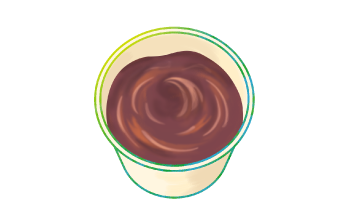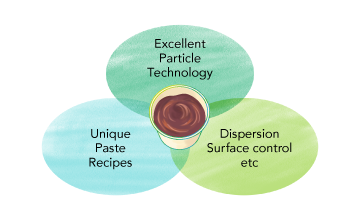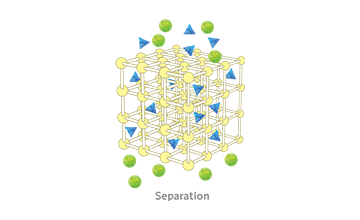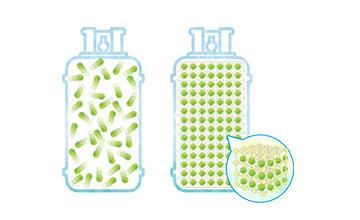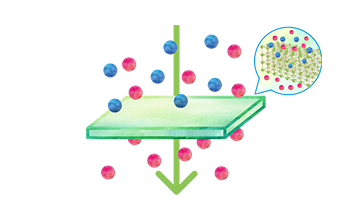Cu sinter paste additionally offers an environmental benefit by eliminating lead when replacing solder.
Aside from power devices, Mitsui Kinzoku also seeks to help solve environmental issues in various fields, such as improving the efficiency of renewable energy.
What difficulties did you encounter during research and development?
In the beginning we had no real idea about how to satisfy the properties of copper paste. So, there was a stage where we worked through the required items step by step by introducing prototypes to various customers and getting their feedback. This stage was challenging because, while we realized that launching a new material would be difficult, we also had to decide from the very start what type of material to develop even though the market requirements for it were not yet fixed. So, while we imagined Cu sinter paste being used in the same way as a solder, the fact that the process was different or that the points that needed attention were different meant there were also things we learned from actually having the prototypes tested. Among the customers who tested the prototypes for us, some seem to have investigated them for applications other than bonding.
What are the difficulties of working with Cu sinter paste?
Since oxidation hampers sintering, it seemed like we tried everything possible to counter it. Pristine copper readily oxidizes when left to nature, but treatment of the metal with antioxidants of any sort also hampers sintering. I think it is this pain point that makes Cu sinter paste such a difficult material to work with. Proper management of the copper particles is important to ensure complete control over the sintering of Cu sinter paste. In this respect, we have a wide range of technologies to choose from since Mitsui Kinzoku possesses the powder knowhow necessary to provide solutions to these issues.
Cu sinter paste can bring many benefits but are there also positives for the environment?
Perhaps the most obvious merit is the elimination of lead when Cu sinter paste replaces solder. And, by enhancing the properties of power devices, Cu sinter paste can contribute to energy conservation and the solution of global environmental issues.
Apart from lead elimination, in what other ways is Cu sinter paste superior to conventional solder?
High thermal conductivity is another plus point for Cu sinter paste. While lead based solder has a thermal conductivity of 50 to 60W/(m•k), the bulk thermal conductivity of copper metal is around 400W/(m•k). Since Cu sinter paste is not a perfect mass, its thermal conductivity is somewhat lower at around 200 W/(m•k) but can still be said to be several times better than solder.
You mention Mitsui Kinzoku’s experience with powders as an advantage but were there also hurdles that you had to overcome?
We cannot deny that being a latecomer to paste manufacturing has led to some issues. As we were not recognized as a paste maker, particularly in overseas markets, it was difficult at first to create business channels and establish contacts, and we exhibited at trade fairs to obtain appointments in any way we could. Our knowhow about the experimentation and trial manufacturing needed to make suppositions about power devices was also insufficient. But, little by little, we have improved in these areas. I think there are also things we can tackle just because we are a latecomer—and we need to do these things to stand out. We therefore step forward every year to make exhibitions at trade fairs and presentations at conferences. We are now becoming capable of building trust with customers, but I think we need to repeatedly showcase our products and continue to show our presence.
What are your Group’s future objectives and ideals?
We are aligned with the company’s purpose and wanting to contribute in some way to solving global environmental issues. Although much of what we are now doing is focused mainly on areas relevant to power devices, we also want to contribute in other fields. To give an example, the formation of circuits on substrates in electronic devices employs a wet process which generates waste liquid. If, however, the printing technique used for Cu sinter paste can be applied to form those circuits, we could expect less waste liquid to be generated and the environmental burden to be reduced. Efficiency can also be improved in the field of renewable energy. I also think we can increase our contribution to solving global environmental issues by expanding the scope of all the fields for which Cu sinter paste is relevant.
From a personal viewpoint, is there anything you want to tackle or achieve?
Firstly, I at least want to quickly launch Cu sinter paste into the market. Then, in the longer term, I hope that Cu sinter paste technology is recognized throughout the world, with Mitsui Kinzoku acknowledged as the benchmark and leading producer. Finally, it would be this engineer’s dream if Cu sinter paste, established after so much effort, becomes one of our company’s core technologies.
Interviewee: Shinichi Yamauchi, Technology and Development Group Leader, AST Business Promotion Unit, Business Creation Sector, Mitsui Mining & Smelting Co., Ltd.
(Date of interview: February 21, 2023)
(The company is hereinafter referred to as "Mitsui Kinzoku.")







